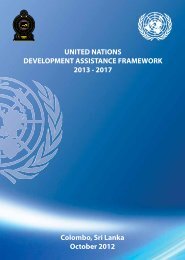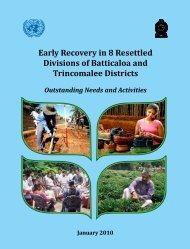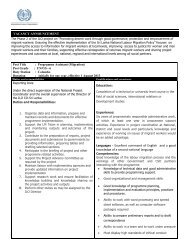Sri Lanka Human Development Report 2012.pdf
Sri Lanka Human Development Report 2012.pdf
Sri Lanka Human Development Report 2012.pdf
You also want an ePaper? Increase the reach of your titles
YUMPU automatically turns print PDFs into web optimized ePapers that Google loves.
across geographic locations and by the level of education.<br />
Compared to the national average, 9.6 percent of workers<br />
in the estate sector are among the working poor, more<br />
than twice the 4.2 percent for urban areas. By level of<br />
education, those who have not passed O-Levels are much<br />
more likely to be considered working poor than those with<br />
higher education. In fact, 91 percent of the working poor<br />
have not passed O-Levels. 219 Women were more likely<br />
to be working poor than men, possibly because more are<br />
unpaid family workers. By employment status, private<br />
sector employees and family workers were most likely to<br />
be poor. Across sectors, the portion of working poor was<br />
highest in agriculture.<br />
The rise in employment from 2000 to 2010 resulted from<br />
employment growth in services and industry. During this<br />
period, total employment grew at 1.5 percent on average<br />
Poverty is higher in agriculture and lowest in services (Table<br />
5.1). It is highest in the estate sector, irrespective of the<br />
type of employment: Over a quarter of estate households<br />
were impoverished in 2006-2007. The considerably higher<br />
rate of poverty stems in part from historical setbacks,<br />
which are clearly evident in poor social infrastructure,<br />
educational attainment and housing. However, the overall<br />
poverty rate in the estate sector fell to 11.4% by 2009-10,<br />
as discussed in Chapter 2.<br />
Despite its low contribution to employment growth,<br />
agriculture in 2010 produced around 12.8 percent of GDP<br />
and was responsible for 33 percent of total employment. 221<br />
Outside the Western Province, it is especially important,<br />
as more than a third of all employed persons are engaged<br />
in it. This proportion is particularly large in Uva and<br />
Table 5.1: Poverty Head Count Index by Employment of Head of Household, %<br />
sri <strong>Lanka</strong> Urban Rural Estate<br />
2006-2007<br />
Agriculture 21.6 8.3 20.8 29.4<br />
Industry 15.1 8.3 16.0 29.2<br />
Services 11.3 6.5 12.1 26.4<br />
Total 15.4 7.1 16.0 28.8<br />
2009-2010<br />
Total 8.9 5.3 9.4 11.4<br />
Note: Poverty data are not yet available by sector for 2009-2010.<br />
Source: Department of Census and Statistics of <strong>Sri</strong> <strong>Lanka</strong> 2011a<br />
per year. 220 In comparison, the increases in industry and<br />
services were 2.5 and 2.0 percent, respectively. Employment<br />
in agriculture grew by a marginal 0.2 percent. In absolute<br />
terms, the total number of employed persons rose by<br />
almost a million. Around 61 percent of new jobs were in<br />
services, followed by 31 percent in industry and 8 percent<br />
in agriculture.<br />
North Central provinces, where it employs 59 percent of<br />
workers (Figure 5.3). Expenditure on agriculture, at 1.1<br />
percent of GDP in 2007, is higher than for other South<br />
Asian countries, except for Bhutan at 2.2 percent in 2007<br />
and the Maldives at 1.3 percent that year. It is lower<br />
than for countries like Thailand, and way below China’s<br />
expenditure. 222<br />
84<br />
sri lanka <strong>Human</strong> <strong>Development</strong> report 2012






